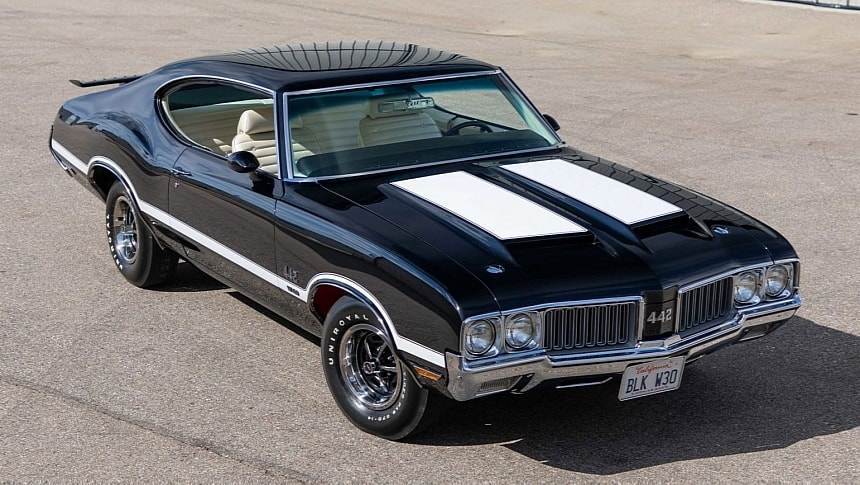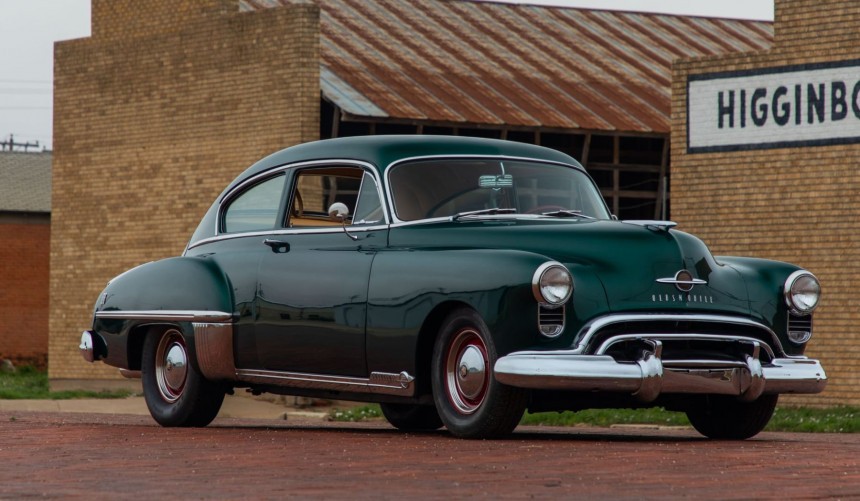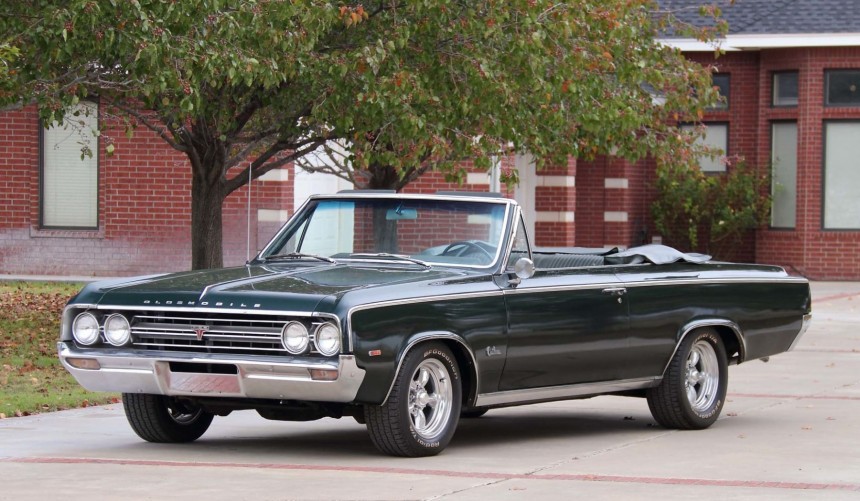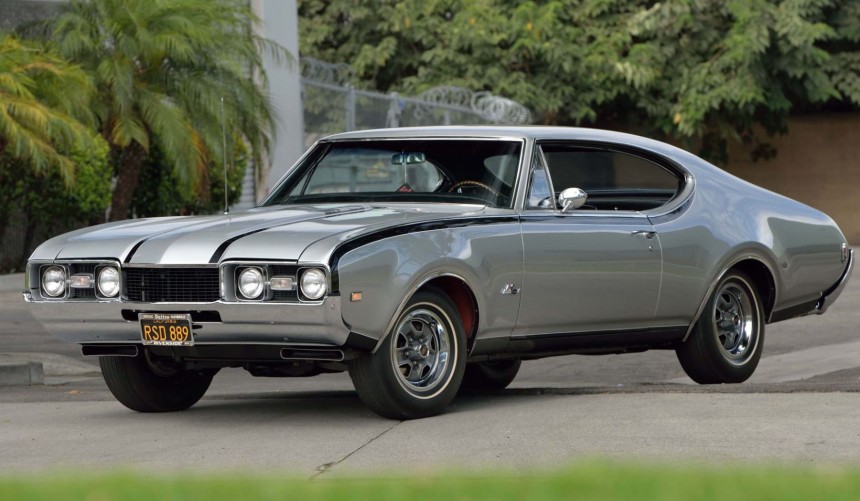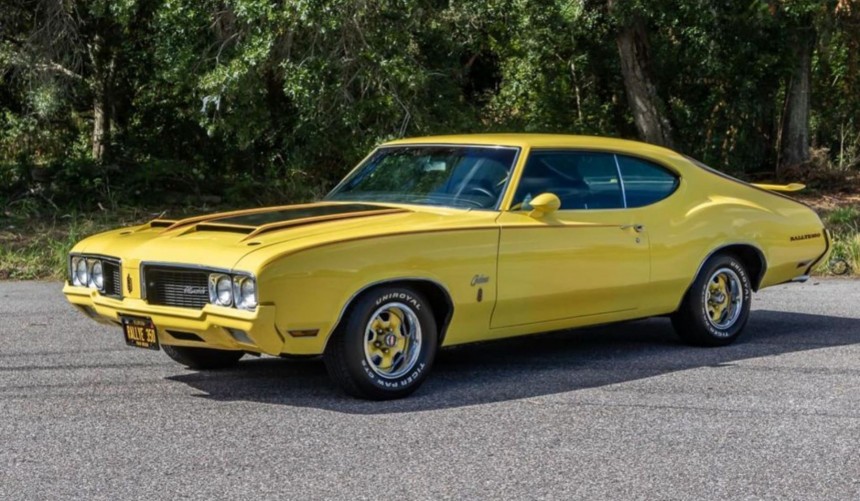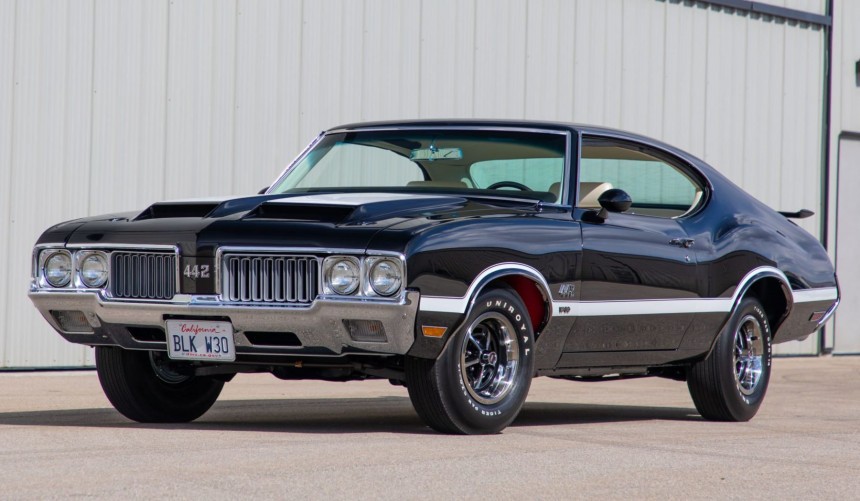Though the GM division didn't prioritize performance, Oldsmobile unleashed some of the most epic muscle cars ever built.
Founded in 1897 by Ransom E. Olds, Oldsmobile became the first high-volume gasoline-powered car manufacturer and the top-selling car company in the US during the early 1900s.
It was an independent carkaher for only about a decade, joining General Motors in 1908.
Throughout its years as a GM division, Oldsmobile was positioned above Checcy and Pontiac but below Buick and Cadillac, focusing on delivering upscale vehicles.
Though this was the main focus until its demise in 2004, Oldsmobile contributed to the excitement of the muscle car era with some legendary vehicles
During the 1940s, Oldsmobile was known for pioneering breakthrough technologies in its production vehicles, with the most famous example being the Hydra-Matic, which was the first mass-produced, fully automatic gearbox.
However, by the end of the decade, the division's vehicles were seen as too conservative (if not boring) by the younger car-buying public, so sales started to dip.
In an effort to revitalize its image, Olds made the decision to replace its mid-range, straight-six-powered 78 with the 88, a revamped model that hid a brand-new V8 under the hood.
Called Rocket, the new V8 designed by GM's chief engineer, Charles Kettering, produced 135 hp and 253 lb-ft (343 Nm), which made it one of the most powerful V8s available in an American passager car at the time.
The combination of the powerful V8 and the relatively light chassis made the 88 (often called Rocket 88) a surprisingly quick car for its era, so, naturally, younger buyers started returning to Oldsmobile's dealership, and they did so in bunches.
Considered the first American muscle car by many historians, the Olds 88 was a marketing sensation, a virtually unbitable NASCAR superstar, and, last but not least, a cultural icon.
The original 88 was discontinued after the 1953 model year, and for the next decade, Oldsmobile slowly but surely took a step back from offering exciting passenger cars.
That changed midway through the 1964 model year, as fellow GM stablemates Pontiac introduced the surprisingly popular GTO package for its LeMans.
Since the concept of an intermediate powered by a potent V8 sourced from a full-size model proved wildly successful, Olds answered back with its own performance package: the 4-4-2.
Created by a small team of Olds enthusiasts that included John Beltz (later responsible for the FWD Toronado), Dale Smith, and division chief engineer Bob Dorshimer, the 4-4-2 became available on the F-85 or Cutlass.
Named after the combination of four-barrel carburetor, four-speed manual transmission, and dual exhausts, the package included a heavy-duty suspension system, a wider wheel and tire combo, a 3.36:1-ratio performance rear end, and, of course, a bespoke, four-barrel carbureted 330-ci (5.4-liter) V8 rated at 310 hp and 355 lb-ft (481 Nm) of torque.
Able to run the quarter mile in 15.5 seconds at 90 mph (140 kph), as evidenced by an independent test conducted by Motor Trend magazine, the 1964 4-4-2 signaled the return of excitement to the Oldsmobile ranks.
Though it wasn't as successful as the Pontiac GTO, it proved to be an important building block for the epic high-performance Oldsmobiles that followed.
From 1965 onwards, the 4-4-2 was continually developed and improved, becoming an important part of Oldsmobile's lineup.
In 1968, the division's enthusiastic engineers decided to take their flagship muscle car one huge step forward, but GM's self-imposed 400-ci limit on intermediates hindered the process.
To bypass the ban, Olds teamed up with Hurst Performance, who became responsible for assembling the most powerful car that Olds had released until that point.
Dubbed Hurst/Olds, the 4-4-2-based fastback received a 455-ci (7.5-liter) Rocket V8 rated 390 hp and a whopping 500 lb-ft (678 Nm) of twist.
Hooked to a three-speed Turbo-Hydramatic 400 with a console-mounted Hurst Dual-Gate shifter, the humongous engine enabled the Hurst/Olds to achieve high-13-second quarter-mile runs in bone-stock form, which made it one of the quickest muscle cars of 1968.
The original Hurst/Olds returned in 1969 with a new white/gold paint scheme and 380 hp on tap, after which it was discontinued.
Olds revived the nameplate as part of three separate runs (1972-1975, 1979, and 1983–1984), but none of the resulting cars were as impressive as the original Hurst/Olds.
For the 1970 model year, the horsepower war entered its last, most epic battle, and the biggest news was GM's decision to lift its self-imposed 400-ci ban for intermediate V8s.
That meant Olds was no longer required to enlist Hurts Performance for its most powerful muscle car, and the Hurst/Olds was abandoned in favor of the W-30-equipped 4-4-2, which became the division's most fearsome high-performance intermediate.
Apart from the 4-4-2, Olds chose to try their luck in the affordable muscle segment by developing the Rallye 350.
A $158.98 option available on the Cutlass S Holiday, Cutlass Sports Coupe, or the F-85 Sports Coupe, the Rallye 350 was only available in an all-yellow paint scheme.
It featured 14-inch Styled Super Stock II sports wheels finished in, of course, yellow, body-colored, Eurothane-coated bumpers, blacked-out grilles, a fiberglass hood with functional intakes, unique Rallye 350 decals combined with a side stripe package, and a four-spoke sport steering wheel.
Hardware-wise, the option brought the heavy-duty Rallye-Sport suspension, 4-4-2-style dual exhausts, and a 3.23:1 ratio rear end.
Available either with the standard three-speed manual, an optional M20 four-speed manual, or a three-speed TH350 automatic, the budget muscle car's only available engine was a high-compression, four-barrel-carburated version of the 350-ci (5.7-liter) rated at 310 hp and 390 lb-ft (529 Nm) of torque.
Though it packed decent hardware and power for its price range, the Rallye 350's yellow-only appearance was too much for many buyers who went from rivaling budget performance cars.
While it wasn't the sales success that it could've been due to Oldsmobile's questionable decision to exclude any other exterior color, the Rallye 350 remains one of the division's best performance cars from the golden age of muscle.
As I mentioned earlier, on the other side of the spectrum for Olds performance enthusiasts was the mighty W-30-equipped 4-4-2.
Like the Rallye 350, the 1970 4-4-2 was also based on Oldsmobile's intermediate Sports Coupes and featured a twist-lock fiberglass hood with functional scoops.
However, it looked a lot better since it was available in a wide range of colors, had chromed bumpers, a more exciting decal package, and donned one of the finest-looking, luxury-oriented interiors of the original muscle car era.
Looks aside, the 4-4-2 was a different kind of monster due to its humongous 455-ci (7.5-liter) V8 that stood between two 4-4-2-exclusive, orange-painted inner fenders made from plastic to reduce weight.
Equipped with the high-performance W-30 option, the 455 Rocket V8 received revised heads, a hotter cam, an aluminum intake manifold, a low-restriction air cleaner, and an improved four-barrel carburetor.
On paper, this amounted to 370 hp and 500 lb-ft (680 Nm), which meant only 5 extra horses over the non-W-30 engine. However, the true output of 400+ hp was intentionally underrated to keep insurance companies from going crazy with their rates.
Considered the ultimate gentleman's muscle car by many enthusiasts, the 1970 Olds 4-4-2 W-30 remains the most epic high-performance intermediate to receive Oldsmobile badges.
It was an independent carkaher for only about a decade, joining General Motors in 1908.
Throughout its years as a GM division, Oldsmobile was positioned above Checcy and Pontiac but below Buick and Cadillac, focusing on delivering upscale vehicles.
Though this was the main focus until its demise in 2004, Oldsmobile contributed to the excitement of the muscle car era with some legendary vehicles
1949 Oldsmobile Rocket 88
However, by the end of the decade, the division's vehicles were seen as too conservative (if not boring) by the younger car-buying public, so sales started to dip.
In an effort to revitalize its image, Olds made the decision to replace its mid-range, straight-six-powered 78 with the 88, a revamped model that hid a brand-new V8 under the hood.
Called Rocket, the new V8 designed by GM's chief engineer, Charles Kettering, produced 135 hp and 253 lb-ft (343 Nm), which made it one of the most powerful V8s available in an American passager car at the time.
The combination of the powerful V8 and the relatively light chassis made the 88 (often called Rocket 88) a surprisingly quick car for its era, so, naturally, younger buyers started returning to Oldsmobile's dealership, and they did so in bunches.
Considered the first American muscle car by many historians, the Olds 88 was a marketing sensation, a virtually unbitable NASCAR superstar, and, last but not least, a cultural icon.
1964 Oldsmobile Cutlass 4-4-2
That changed midway through the 1964 model year, as fellow GM stablemates Pontiac introduced the surprisingly popular GTO package for its LeMans.
Since the concept of an intermediate powered by a potent V8 sourced from a full-size model proved wildly successful, Olds answered back with its own performance package: the 4-4-2.
Created by a small team of Olds enthusiasts that included John Beltz (later responsible for the FWD Toronado), Dale Smith, and division chief engineer Bob Dorshimer, the 4-4-2 became available on the F-85 or Cutlass.
Named after the combination of four-barrel carburetor, four-speed manual transmission, and dual exhausts, the package included a heavy-duty suspension system, a wider wheel and tire combo, a 3.36:1-ratio performance rear end, and, of course, a bespoke, four-barrel carbureted 330-ci (5.4-liter) V8 rated at 310 hp and 355 lb-ft (481 Nm) of torque.
Able to run the quarter mile in 15.5 seconds at 90 mph (140 kph), as evidenced by an independent test conducted by Motor Trend magazine, the 1964 4-4-2 signaled the return of excitement to the Oldsmobile ranks.
Though it wasn't as successful as the Pontiac GTO, it proved to be an important building block for the epic high-performance Oldsmobiles that followed.
1968 Hurst/Olds
In 1968, the division's enthusiastic engineers decided to take their flagship muscle car one huge step forward, but GM's self-imposed 400-ci limit on intermediates hindered the process.
To bypass the ban, Olds teamed up with Hurst Performance, who became responsible for assembling the most powerful car that Olds had released until that point.
Dubbed Hurst/Olds, the 4-4-2-based fastback received a 455-ci (7.5-liter) Rocket V8 rated 390 hp and a whopping 500 lb-ft (678 Nm) of twist.
Hooked to a three-speed Turbo-Hydramatic 400 with a console-mounted Hurst Dual-Gate shifter, the humongous engine enabled the Hurst/Olds to achieve high-13-second quarter-mile runs in bone-stock form, which made it one of the quickest muscle cars of 1968.
The original Hurst/Olds returned in 1969 with a new white/gold paint scheme and 380 hp on tap, after which it was discontinued.
Olds revived the nameplate as part of three separate runs (1972-1975, 1979, and 1983–1984), but none of the resulting cars were as impressive as the original Hurst/Olds.
1970 Oldsmobile Rallye 350
That meant Olds was no longer required to enlist Hurts Performance for its most powerful muscle car, and the Hurst/Olds was abandoned in favor of the W-30-equipped 4-4-2, which became the division's most fearsome high-performance intermediate.
Apart from the 4-4-2, Olds chose to try their luck in the affordable muscle segment by developing the Rallye 350.
A $158.98 option available on the Cutlass S Holiday, Cutlass Sports Coupe, or the F-85 Sports Coupe, the Rallye 350 was only available in an all-yellow paint scheme.
It featured 14-inch Styled Super Stock II sports wheels finished in, of course, yellow, body-colored, Eurothane-coated bumpers, blacked-out grilles, a fiberglass hood with functional intakes, unique Rallye 350 decals combined with a side stripe package, and a four-spoke sport steering wheel.
Hardware-wise, the option brought the heavy-duty Rallye-Sport suspension, 4-4-2-style dual exhausts, and a 3.23:1 ratio rear end.
Available either with the standard three-speed manual, an optional M20 four-speed manual, or a three-speed TH350 automatic, the budget muscle car's only available engine was a high-compression, four-barrel-carburated version of the 350-ci (5.7-liter) rated at 310 hp and 390 lb-ft (529 Nm) of torque.
Though it packed decent hardware and power for its price range, the Rallye 350's yellow-only appearance was too much for many buyers who went from rivaling budget performance cars.
While it wasn't the sales success that it could've been due to Oldsmobile's questionable decision to exclude any other exterior color, the Rallye 350 remains one of the division's best performance cars from the golden age of muscle.
1970 Oldsmobile 4-4-2 W-30
Like the Rallye 350, the 1970 4-4-2 was also based on Oldsmobile's intermediate Sports Coupes and featured a twist-lock fiberglass hood with functional scoops.
However, it looked a lot better since it was available in a wide range of colors, had chromed bumpers, a more exciting decal package, and donned one of the finest-looking, luxury-oriented interiors of the original muscle car era.
Looks aside, the 4-4-2 was a different kind of monster due to its humongous 455-ci (7.5-liter) V8 that stood between two 4-4-2-exclusive, orange-painted inner fenders made from plastic to reduce weight.
Equipped with the high-performance W-30 option, the 455 Rocket V8 received revised heads, a hotter cam, an aluminum intake manifold, a low-restriction air cleaner, and an improved four-barrel carburetor.
On paper, this amounted to 370 hp and 500 lb-ft (680 Nm), which meant only 5 extra horses over the non-W-30 engine. However, the true output of 400+ hp was intentionally underrated to keep insurance companies from going crazy with their rates.
Considered the ultimate gentleman's muscle car by many enthusiasts, the 1970 Olds 4-4-2 W-30 remains the most epic high-performance intermediate to receive Oldsmobile badges.
